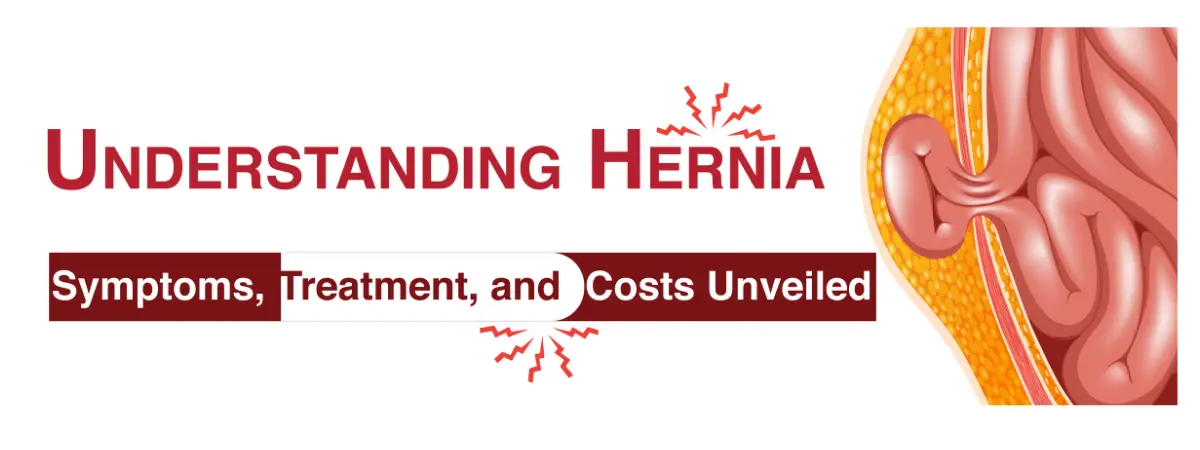Working Time
| Mon,Tue,Wed,Fri,Sat | 09:00am to 04:00pm |
| Thursday&Sunday | Holiday |
| Other Time | On Appointment |
Book Appointment

Introduction:
A hernia is a common medical condition that occurs when an organ or tissue protrudes through an opening or weak spot in the surrounding muscles or connective tissue. While hernias can develop in various parts of the body, they most commonly occur in the abdomen. In this blog post, we will explore the symptoms, diagnosis, and available treatments for hernias to provide a comprehensive understanding of this condition.
Symptoms of Hernia:
Visible Bulge: One of the primary signs of a hernia is the presence of a visible bulge or lump, particularly when standing, coughing, or straining. The bulge may disappear when lying down.
Discomfort or Pain: Individuals with a hernia may experience discomfort or pain in the affected area. The pain can range from mild to severe and may worsen during activities such as lifting or bending.
Feeling of Heaviness: Some people describe a sensation of heaviness or pressure in the abdomen or affected area, especially after standing for an extended period.
Gastrointestinal Symptoms: Hernias in the abdominal region can sometimes lead to gastrointestinal symptoms such as heartburn, acid reflux, or difficulty swallowing.
Changes in Bowel Habits: In certain cases, hernias can cause changes in bowel habits, including constipation or difficulty with bowel movements.
Diagnosis of Hernia:
Physical Examination: During a physical examination, a healthcare professional may identify a hernia by palpating the affected area and observing any visible bulges or lumps.
Medical History: A detailed medical history is crucial for understanding the onset and nature of symptoms. It helps healthcare providers determine the appropriate diagnostic tests and treatment options.
Imaging Studies: In some cases, imaging studies such as ultrasound, CT scans, or MRI may be recommended to get a clearer picture of the hernia and its location. These tests can help confirm the diagnosis and guide treatment planning.
Barium Swallow or Upper Endoscopy:
For hiatal hernias, which occur in the upper part of the stomach, a barium swallow or upper endoscopy may be performed to visualize the esophagus and stomach and identify any abnormalities.
Treatments for Hernia:
Watchful Waiting: In some cases, especially if the hernia is small and not causing significant symptoms, a healthcare provider may recommend a watchful waiting approach. Lifestyle modifications, such as avoiding heavy lifting and managing constipation, may be advised.
Hernia Belts or Trusses: For individuals with reducible hernias, where the protruding tissue can be pushed back into place, hernia belts or trusses may provide support and help alleviate symptoms. However, these are usually considered temporary solutions.
Lifestyle Changes: Adopting lifestyle changes can be beneficial in managing hernia symptoms. This may include maintaining a healthy weight, avoiding heavy lifting, practicing good posture, and addressing conditions like constipation.
Medications: Over-the-counter or prescription medications may be recommended to manage symptoms associated with hernias, such as heartburn or acid reflux. However, medications do not address the hernia itself.
Surgery: Surgical intervention is often considered the most effective treatment for hernias, especially if they are causing significant symptoms or complications. There are different surgical approaches, including traditional open surgery and minimally invasive procedures like laparoscopic surgery.
Open Surgery: In open surgery, a larger incision is made to repair the hernia by returning the protruding tissue to its original position and reinforcing the weakened muscles or tissues.
Laparoscopic Surgery: This minimally invasive approach involves smaller incisions and the use of a camera and specialized instruments to repair the hernia.
Laparoscopic surgery often results in shorter recovery times and reduced postoperative pain.
Hiatal Hernia Repair: Hiatal hernias, which occur in the upper part of the stomach, may be treated with lifestyle changes, medications to reduce acid reflux, or, in severe cases, surgical repair.
Conclusion:
Hernias are a common medical condition that can affect people of all ages. Recognizing the symptoms, obtaining a timely diagnosis, and considering appropriate treatments are essential steps in managing hernias effectively. If you suspect you have a hernia or are experiencing symptoms associated with hernias, it's crucial to consult with a healthcare professional for a thorough evaluation and personalized treatment plan. Whether through lifestyle modifications, supportive measures, or surgical intervention, addressing hernias promptly can contribute to improved quality of life and overall well-being.
About the Author:
Allow us to introduce Dr. Moode Jayanth, a distinguished medical expert and leading gastroenterologist located in Somajiguda. With a robust educational background, including an MBBS, MS in General Surgery, and DNB in Surgical Gastroenterology, Dr. Jayanth proudly serves as a Consultant Surgical Gastroenterologist and Robotic Surgeon. His unwavering commitment to advancing healthcare is clearly reflected in his impressive qualifications, which encompass FIAGES and FALS in Robotic Surgery. Dr. Jayanth's wealth of experience significantly enhances our exploration of the crucial connection between optimal food choices and overall health.
Recent Posts
- Understanding Leaky Gut Syndrome: Insights by Dr. Moode Jayanth
- "Understanding Stomach Ulcers: Insights by Dr. Moode Jayanth"
- "Gastroschisis Awareness Day: Key Facts and Ways to Take Action!"
- Global Hepatitis Awareness: Insights by Dr. Moode Jayanth
- Understanding Stomach Flu: Insights by Dr. Moode Jayanth
- "Optimizing Colon Health: Harnessing the Power of a High-Fiber Diet"
- Managing GERD: A Guide to Foods for Relief and Prevention
- Unveiling Gallstones: Symptoms, Diagnosis, and Treatment Options
- Understanding Hernia: Symptoms, Diagnosis, and Treatments
- Know Major Causes and Best Remedies for Abdominal Bloating